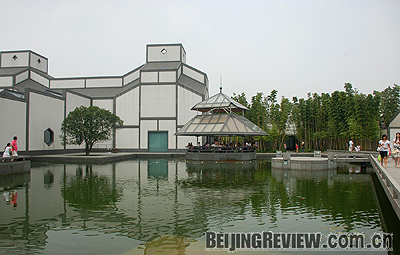|

MUSEUM AND ART:Suzhou Museum, said to be the last masterpiece of Chinese-American architect Ieoh Ming Pei, matches its surroundings in color but stands out for its modern design (JING XIAOLEI)
It was a hot and humid Saturday morning in Suzhou, but the uncomfortable weather didn't stop tourists and locals from visiting Suzhou Museum, an unusual angular white-and-gray building, designed by architect Ieoh Ming Pei, better known as I.M. Pei.
Completed in October 2006, the museum covers 10,700 square meters, including a 5,000-square-meter exhibition space, a 200-seat auditorium, a research library and several Chinese gardens. It contains a number of significant cultural relics and has become one of the most highly regarded regional museums in China.
"He used the geometrical form as his basic element and repeated the theme throughout," said Jia Beisi, Associate Professor of architecture at the University of Hong Kong. "The design looks like a big building cut into smaller pieces."
Whitewashed plaster walls with dark gray clay tiles are a traditional feature of Suzhou's architecture. The museum mirrors but doesn't copy this with its roof made of gray granite in uniform colors.
A modern steel structure replaces the traditional wooden roof beam of Suzhou. The interior is decorated with wooden frames beneath a white ceiling. In addition, metal sunscreens with wooden panels make the building more flexible to changes in natural light, a skillful creation by I.M. Pei who has been given the nickname "magician of light."
"I visit Suzhou Museum a lot. Every time I take a tour, I always find something new," Xia Yanhong, an art student from Soochow University, told Beijing Review.
Built with the design concept, "Chinese style with innovation, Suzhou style with creativity" and the idea, "not too high, not too large and not too abrupt," the museum is interesting and comprehensive yet remains manageable on a human level.
It has the style of a Suzhou garden, but also contains the simple geometric form of modern art as well as a functional layout.
"I don't like to give people the impression that the new museum is built of money," Pei said. He explained that since there are many traditional cultural elements and unique building materials available, the Chinese people are able to easily represent their unique culture.
In 2001, the mayor of Suzhou approached Pei to design a museum at a unique location: deep in a historical cultural district at the intersection of two canals in the northeast corner of the city, close to an ancient palace, and backed against the Zhuozheng Garden (Humble Administrator's) built in 1509 during the Ming Dynasty, a UNESCO-designated world heritage.
| 